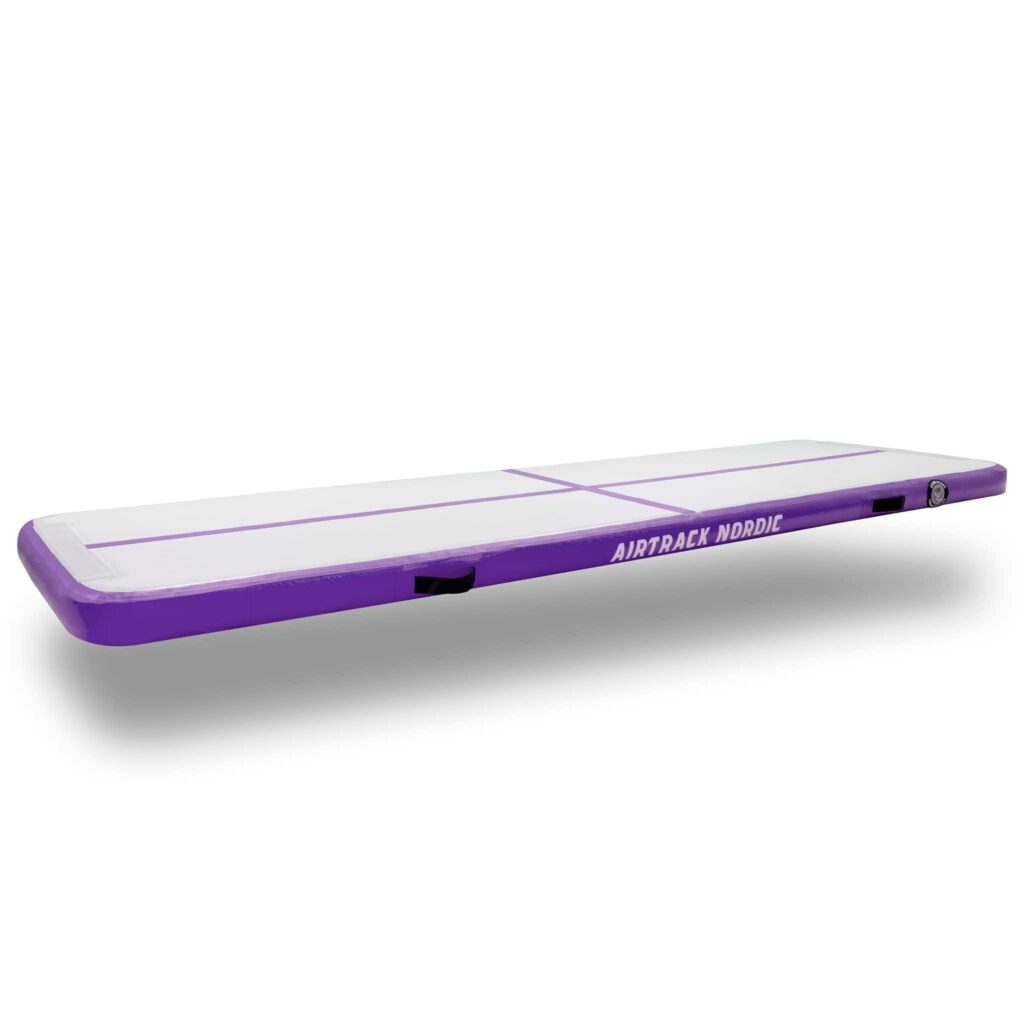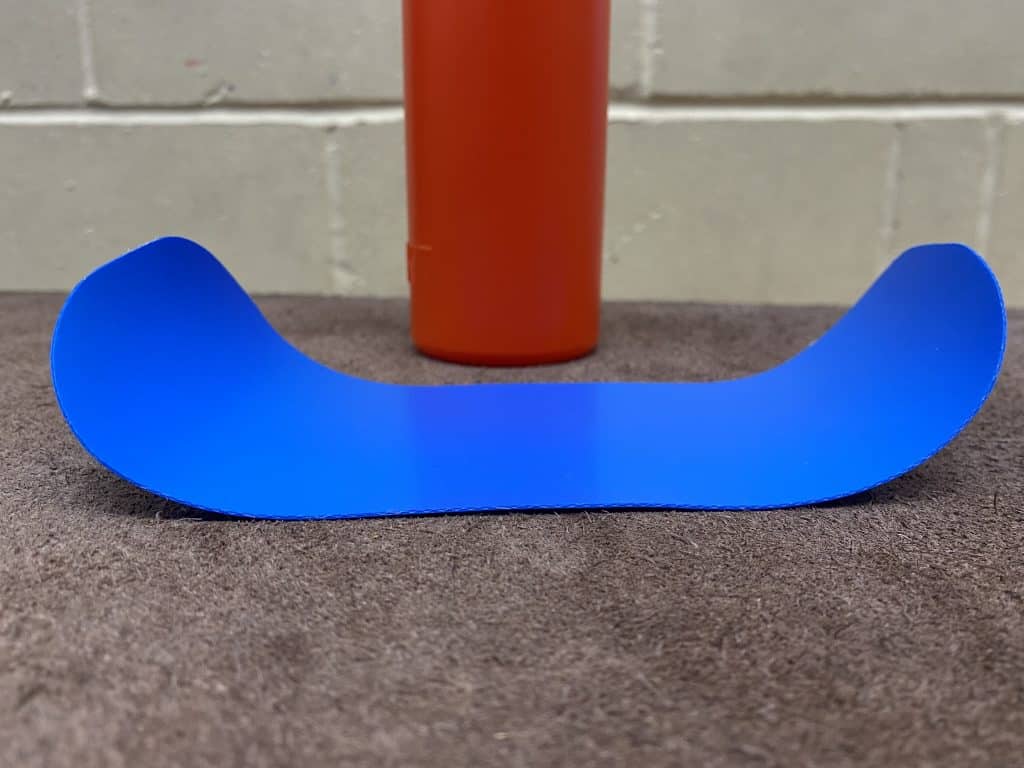Gymnastics Air Tracks are not cheap and there is nothing worse than investing in a piece of kit that doesn’t last very long. On the other hand, well-maintained Air Tracks can last for five or six years or longer. I’ve even been able to keep Air Tracks in good working order for up to 10 years by maintaining them properly.
If you want to extend the life of your Air Track, carefully follow the steps I have laid out in this guide.

Where To Use an Air Track
Air tracks can be used on a range of surfaces both inside and outside including grass, sand or even water.
But before inflating your air track carefully check the ground for any sharp objects that could potentially damage or rip the material. If you are outside you will need to clear twigs, tree branches, stones and litter. If you are inside the house check that there are no sharp edges or dirt on the floor.
Also, be aware that on extremely hot days the surface under your air track will heat up and potentially damage the material. For this reason, I would avoid using an air track on concrete or asphalt. These types of rough surfaces are more likely to rip the material even on cooler days.
In a professional gymnastics facility, an air track will usually be set up on top of a carpeted surface like a sprung floor or tumble track. My recommendation would be to also set up an air track at home on a carpeted surface wherever possible.
Shoes and Air Tracks
Some people may disagree with me on this one but if you are serious about having a long-lasting Air Track you should use it without shoes. Outdoor shoes can pick up dirt and small objects and without realizing they could be transferred onto the air track and cause damage. It’s also more hygienic to remove shoes!
For anyone who insists on flipping with shoes, I would recommend having a set of shoes that are not worn outside.
Weight Limit
Having multiple people on an air track will put added pressure on the seams that hold the material together. Over some time, these seams will eventually give way and air will escape or worse still the air track will completely pop.
For this reason, I recommend only one person at a time use an air track.
There’s also a safety factor with this rule as collisions are more likely to happen with multiple people flipping and tumbling together at the same time.
Cleaning your air track
Clean your air track regularly to keep it free from dirt and mold that can potentially damage your air track. Ideally, clean it after every use but if you don’t have enough time try and clean it at least once a week. To clean an air track wipe it down with a cloth and disinfectant spray. Check the instructions that came with your air track in case they have specific products that can’t be used. I’ve always used a regular bottle of spray from the store without a problem.
After cleaning it is very important to allow the air track to dry completely before folding it or storing it.
Folding your air track correctly
When you have finished using your air track it’s super important to fold it carefully and correctly before storing it away. The best way to fold your particular air track will be to do it in the same way it was delivered to you from the factory when brand new!
As a rule, most air tracks will fold in thirds lengthwise along the track.
Firstly ensure the air track is completely deflated and the valve is open.
Then begin to fold the air track over, pressing down to help push out any remaining air. Ensure there are no creases in the fabric and it is completely flat once folded lengthwise. Longer air tracks (12 meters plus) are usually rolled into a cylindrical shape whereas shorter, lighter air tracks will be folded in straight lines two or three times across the width.
This should make the air track small enough to be stored. If you are finding it difficult to fold your air track it’s usually because of air still trapped inside so re-check the valve is open.
How to store your air track
Once your air track is folded correctly, it can be stored. Air Tracks can easily be damaged while not being used so storage is important. For storage, the Air Track must be stored:
- Dry- use a towel or dry cloth to wipe down. Any moisture will eventually turn to mold.
- Away from direct sunlight – this can cause loss of shape to the material
- Inside – away from the weather elements that can cause damage
- In a clear space – don’t place other objects on top or next to it, especially ones that can rip the material
The pump also needs to be stored somewhere safe to avoid damage. As much as the pump can be replaced easily it can cost around $100 to buy a new one.
Air Track Repair Kits
Hopefully, you will never need to use it, but air track punctures can be repaired in a very similar way to bicycle punctures. A repair kit (pictured below) will consist of some spare material and strong glue that can be placed over a small rip or tear. If you can’t find where the air is escaping from use water and look for any bubbles.


High-quality Air Track brands such as Air Track US and Air Track Nordic often supply a small amount of material that can be used to repair holes or tears in the air track.
On older air tracks, air will eventually start to leak through the seams which are almost impossible to repair. Once your air track reaches this point and is becoming too soft, it’s probably time to buy a new one!
Choose a good quality Air Track
If you want a product that is less likely to tear and will last longer you should be prepared to spend a little bit more. My top brands for inflatable mats and Air Tracks at home are Air Track Factory, Fbsport and Air Track Nordic. They are made from premium quality material with a thickness that won’t pop easily. You can read more about why I recommend them in my article.
10% Discount at Fbsport Using the code Synergy10
The cost of an air track will depend on the length you want but to give a rough idea, a good quality 16ft mat will cost between $300-$500. Anything less than that may not be made to last.
Also, check the warranty on the products. Air Track Factory gives a 5-year warranty which is excellent and shows they believe in their product.
Final thoughts
The more time you spend maintaining your air track properly, the longer it will last. With a good quality product, you should be aiming to get at least 5 or 6 years’ lifespan from it.
All of the steps in this guide can be applied to other inflatable gymnastics products such as air beams, air rollers, or air spots.
FAQs
Can you leave an air track outside?
It’s not advisable to leave an air track outside, especially in harsh weather such as wind and rain. In the summertime, you can potentially leave an air track outside without it getting damaged too much. If your air track uses an electric pump to inflate it, ensure the pump is not left outside.
What type of glue can be used to repair an air track?
Heavy-duty glue such as Gorilla glue is recommended to repair an air track. Ensure that your chosen glue is suitable for use on PVC.

How do you patch an air track?
If a hole appears on an air track it can often be patched up in the same way a puncture on a bicycle wheel can be repaired. Use a piece of air track fabric and strong glue to patch over the hole and leave it to dry as per the instructions on the glue.
Why does my air track keep deflating?
If your air track is deflating it is due to air escaping. There are a few common places where air tends to escape most easily; the valve, stitching or through a tear in the fabric. Valves and stitching suffer from wear and tear and are difficult to repair. However, if a rip has occurred in the fabric you may be able to repair it.
How do you deflate an air track?
To deflate an air track set the valve to the deflate position and roll the air track from the furthest point away towards the valve. This will push any remaining air out through the valve. Some air track blowers also have a deflate setting which sucks the air
